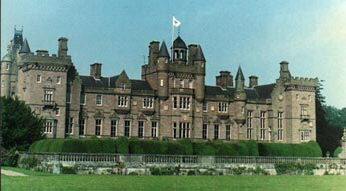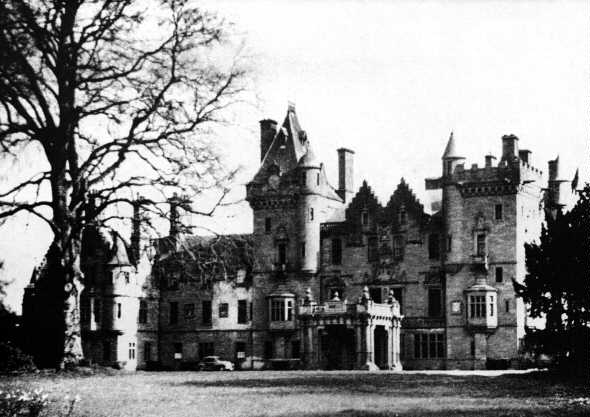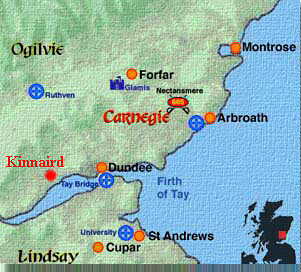It was in 1405 that Duthac Carnegie
married Mariota, the owner of Kinnaird ( in Angus), and he soon acquired the neighbouring
lands, which James V elevated into a barony by a Charter under the Great Seal.
 The Carnegies
and the King must have been on very friendly terms, for the "reddendo," or
service rendered in payment by the family, was "one silver penny per year," plus
the duty of maintaining the King's ale cellar in Angus "against his residence
there."
The Carnegies
and the King must have been on very friendly terms, for the "reddendo," or
service rendered in payment by the family, was "one silver penny per year," plus
the duty of maintaining the King's ale cellar in Angus "against his residence
there."
It was in the days of the first Earl of
Southesk that this "reddendo" was called into operation. In 1617, King James VI
enjoyed the hospitality of Kinnaird on a long-delayed visit to Scotland. He had some
wonderful days during this break from the cares of State, for he went "chasing the
wild deer and following the roe" over nearby Montreathmont Moor.
 Kinnaird Castle was also visited by
Charles I and Charles II. In the winter of 1715 the Old Pretender spent some time at the
castle; but, alas, as a result of this, and of the Earl's adherence to the Stuart cause
during the 1715 Jacobite Rebellion, his title and estate were forfeited. Eventually,
however, they were recovered in 1764. Nearer our own time - in 1921 - much of the castle
was destroyed by fire, and had to be rebuilt. It takes the form of a magnificent
"chateau" and is delightful in its conical turrets, steep roofs, and armorial
decorations. Kinnaird Castle is set in extensive parklands where herds of Highland cattle
and fallow-deer roam. There are also formal gardens, a lake, and riverside walks alongside
some fine salmon-fishing pools.
Kinnaird Castle was also visited by
Charles I and Charles II. In the winter of 1715 the Old Pretender spent some time at the
castle; but, alas, as a result of this, and of the Earl's adherence to the Stuart cause
during the 1715 Jacobite Rebellion, his title and estate were forfeited. Eventually,
however, they were recovered in 1764. Nearer our own time - in 1921 - much of the castle
was destroyed by fire, and had to be rebuilt. It takes the form of a magnificent
"chateau" and is delightful in its conical turrets, steep roofs, and armorial
decorations. Kinnaird Castle is set in extensive parklands where herds of Highland cattle
and fallow-deer roam. There are also formal gardens, a lake, and riverside walks alongside
some fine salmon-fishing pools.
 Parties are often conducted to see the
castle's famous collection of pictures, which includes paintings of the Dutch, Flemish and
Italian schools, as well as works by Jamesone, Raeburn, Durer, Vandyck and Holbein. One of
the castle's great treasures is the bridal portrait by Jamesone of the young and handsome
Marquis of Montrose. The painting was a wedding gift for Montrose's bride, Magdalen
Carnegie of Kinnaird. The Marquis was 17 at this time, and still a student at Aberdeen
University. Later he was to become the cavalier hero of the 17th century, and a great
leader of men. On the Continent, at the Court of Louis XIII, his good looks and courteous
manners even fluttered the heart of the Queen of France !
Parties are often conducted to see the
castle's famous collection of pictures, which includes paintings of the Dutch, Flemish and
Italian schools, as well as works by Jamesone, Raeburn, Durer, Vandyck and Holbein. One of
the castle's great treasures is the bridal portrait by Jamesone of the young and handsome
Marquis of Montrose. The painting was a wedding gift for Montrose's bride, Magdalen
Carnegie of Kinnaird. The Marquis was 17 at this time, and still a student at Aberdeen
University. Later he was to become the cavalier hero of the 17th century, and a great
leader of men. On the Continent, at the Court of Louis XIII, his good looks and courteous
manners even fluttered the heart of the Queen of France !
 The Carnegies
and the King must have been on very friendly terms, for the "reddendo," or
service rendered in payment by the family, was "one silver penny per year," plus
the duty of maintaining the King's ale cellar in Angus "against his residence
there."
The Carnegies
and the King must have been on very friendly terms, for the "reddendo," or
service rendered in payment by the family, was "one silver penny per year," plus
the duty of maintaining the King's ale cellar in Angus "against his residence
there." The name Kinnaird comes from the Gaelic Ceann-airde, meaning
"the head of the hill-rise." And although the castle stands no more than
50 feet above the Vale of the Angus South Esk, its towers command a wide view of
Strathmore and the distant Grampians.
The name Kinnaird comes from the Gaelic Ceann-airde, meaning
"the head of the hill-rise." And although the castle stands no more than
50 feet above the Vale of the Angus South Esk, its towers command a wide view of
Strathmore and the distant Grampians.


